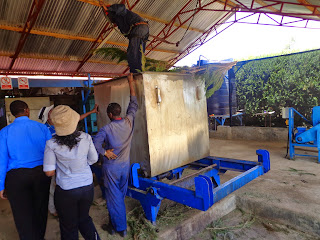Tersea
W. Ndirangu
Kenya Organic Agriculture Network (KOAN), Earthoil Company
Limited and farmers within Nanyuki Laikipia County intend to expend tea tree
production. The project will be
implemented for two years starting from July 2014. It is sponsored by United
Nation Development Programme (UNDP) Global Environment Fund (GEF) Small Grant
Project (SGP). The project aims to
improve food security and livelihoods among small scale producers, women and
youths of Laikipia County through agro ecological approaches and development of
organic tea tree value chain.
|
A farmer at her Tea Tree farm
|
Tea Tree value chain is being promoted in arid and semi arid
areas of Nanyuki due to its resilient properties. The area is among the most affected by
climate change effects such as long dry spells, unpredictable weather and
environmental degradation. Communities
living in the County are a mixer of agriculturalists, pastoralists and ranchers.
In addition, these community members have limited sources of income. The
project therefore aims to expand the production of tea tree since it can
withstand harsh dry conditions.
Currently,
the project is working with 460 farmers spread across Laikipia County (Matanya,
Sweet Water, Marura and Ndurukuma). With
the current scale of production, the farmers are not able to meet the demand of
tea tree oil. As a result, the project
intends to expand and include more framers from Ndurukuma, Thome, Kihato and
Ngare Nyiro areas of Laikipia County in order to increase tea tree oil
production hence meeting the demand.
Tea tree is
suitable in Laikipia County as it is more resilient to effects of climate
change and does well in extreme harsh dry weather conditions. Tea Tree matures
within 15 months after establishment and is harvested twice per year. The crop
requires low labour input. It also requires less field management since it is
not affected by pests, diseases or eaten by any domestic animals. The
production of oil per biomass weight is very high compared to other crops therefore
farmers return per unit area is higher than any other crop grown in this
region.
After tea
tree matures, it will produce to its maximum potential since it’s root system would
have reached its limits of growth. During harvesting time, stem is done by
cutting down the whole 15cm-20cm above the ground. This is done at an angle
using bending saw. Panga is not
recommended for use since it will injure the plant. The central stem is then removed.
Branches and leaves are the one sold.
After a
period of time, the tree which was cut down will grow other shoots from the
point where it was cut. All the shoots
are left to grow, and the farmer is advised to cut them back after 6 months.
This is a continuing cycle. Tea Tree is expected to be highly productive for 25
years under good management.
|
Part of Processing unit
|
|
|


